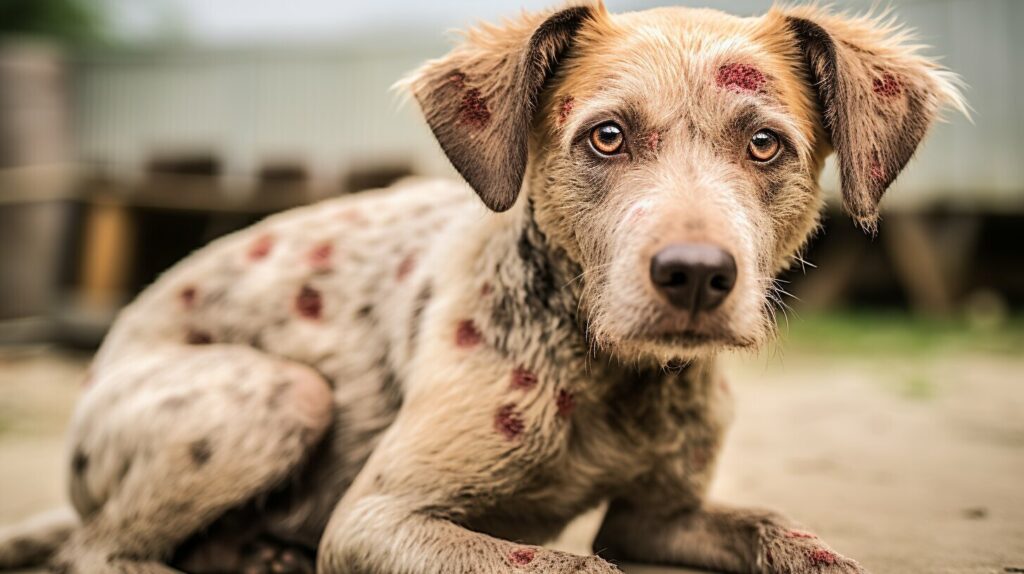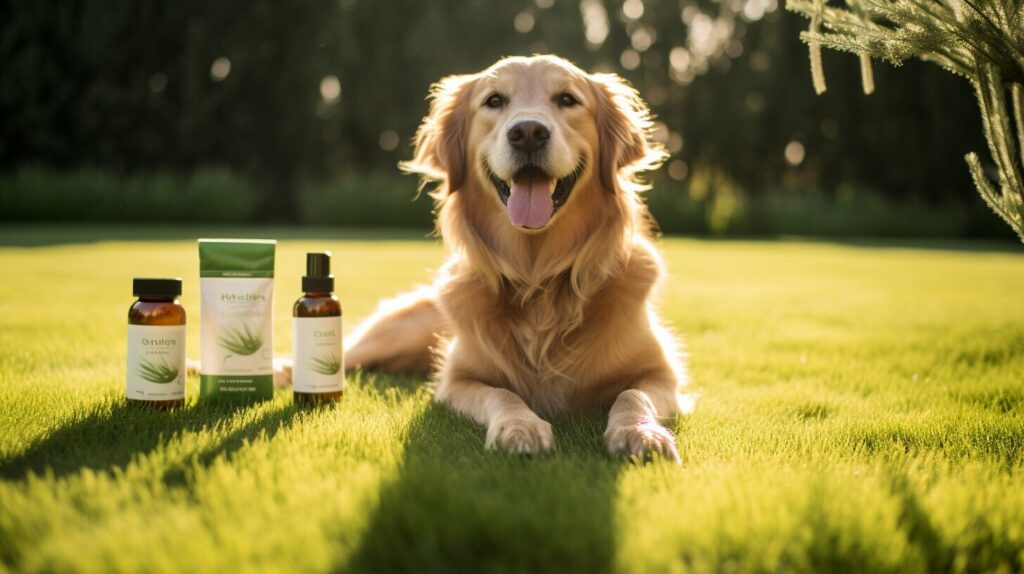If you’re a dog owner, it’s important to be informed about the various health conditions that can affect your furry friend. One such condition is dogs mange, which is a skin disease caused by mites that burrow into a dog’s skin. Mange can cause a range of symptoms, from mild itching and hair loss to more severe skin irritation and infection. In this article, we’ll take a closer look at what dogs mange is, its causes, symptoms, and treatment options.
Key Takeaways
- Dogs mange is a skin disease caused by mites that burrow into a dog’s skin.
- Mange can cause a range of symptoms, from mild itching and hair loss to more severe skin irritation and infection.
- There are several types of mange that can affect dogs, including sarcoptic mange and demodectic mange.
- Diagnosis of dogs mange is done through physical examinations and skin scrapings by a veterinarian.
- Treatment options for dogs mange include medicated shampoos, topical creams, oral medications, and veterinary interventions.
What is Dogs Mange?
If you’re a dog owner, it’s essential to understand what mange is and how it can affect your furry friend’s health and well-being. Dogs mange is a skin condition caused by parasitic mites that burrow into a dog’s skin, causing irritation, hair loss, and other symptoms.
There are two main types of mange that affect dogs: sarcoptic mange and demodectic mange. Sarcoptic mange is caused by Sarcoptes scabiei mites, which can also affect humans. Demodectic mange, on the other hand, is caused by Demodex canis mites and is usually only found in dogs.
The symptoms of mange in dogs can range from mild to severe, depending on the type of mange and the dog’s overall health. Common symptoms of mange in dogs include intense itching, hair loss, redness, and scabbing on the skin.
Mange in dogs can be caused by a variety of factors, such as poor grooming habits, a weakened immune system, or contact with other infected dogs. It’s important to know that mange is a treatable condition with proper veterinary care, so you don’t have to worry about your dog suffering for long.
In the next section, we’ll take a closer look at the different types of mange that can affect dogs, so you can better understand this common skin condition.
Types of Mange in Dogs
Dogs can suffer from different types of mange, and each type is caused by a specific type of mite. Mites are tiny parasites that can live on the skin of dogs and cause a range of skin problems. Some types of mange are more common than others, and they can vary in severity from mild to severe.
Sarcoptic Mange
This type of mange is caused by Sarcoptes scabiei mites that burrow into the skin of dogs. Sarcoptic mange is highly contagious and can be transmitted between dogs and other animals, including humans. Symptoms of sarcoptic mange include intense itching, hair loss, scabs, and skin irritation. Sarcoptic mange can be challenging to treat, and a combination of medication and environmental management is usually necessary.
Demodectic Mange
This type of mange is caused by Demodex canis mites that live on the skin and hair follicles of dogs. Demodectic mange is less contagious than sarcoptic mange and is more common in puppies and dogs with weakened immune systems. Symptoms of demodectic mange include hair loss, scaly and thickened skin, and occasionally sores. Mild cases of demodectic mange can resolve on their own, but severe cases require veterinary treatment.
Cheyletiella Mange
This type of mange is caused by Cheyletiella mites that live on the surface of the skin and feed on skin cells. Cheyletiella mange is highly contagious and can be transmitted between dogs and other animals. Symptoms of Cheyletiella mange include intense itching, dandruff, and scales on the skin. Treatment for this type of mange involves medications to kill the mites and soothe the skin.
Otodectic Mange
This type of mange is caused by Otodectes cynotis mites that live in the ear canal of dogs. Otodectic mange is contagious and can be transmitted between dogs. Symptoms of Otodectic mange include intense itching, head shaking, and ear discharge. Treatment involves medications to kill the mites and soothe the ears.
It is essential to identify the type of mange your dog has to provide appropriate treatment. Your veterinarian can diagnose the type of mange by examining your dog’s skin or conducting skin scrapings. Once the type of mange is identified, your veterinarian can recommend the best treatment plan based on your dog’s overall health and the severity of the condition.
Symptoms of Dogs Mange
Dogs mange can present itself in several different forms, with each type of mange having its own set of symptoms. However, there are a few common signs that you can look out for to determine whether your dog is suffering from mange.
One of the most prominent symptoms of mange in dogs is hair loss. This can occur in patches or be more widespread across the body. Dogs with mange may also experience intense itching and redness of the skin, which can lead to skin lesions or sores.
In addition to these symptoms, dogs with mange may display other signs of discomfort and illness, such as lethargy, loss of appetite, and weight loss. If you notice any of these symptoms in your dog, it is important to seek veterinary attention right away.
While mange can be a serious condition, prompt treatment can help alleviate symptoms and prevent further spread of the disease. By paying attention to your dog’s behavior and observing any changes in their appearance or health, you can catch mange early and ensure that your furry friend receives the care they need to recover.
Causes of Dogs Mange
There are various causes of dogs mange, but the most common culprit is usually some type of mite infestation. Mites are tiny parasites that burrow into the dog’s skin, causing intense itching, hair loss, and skin irritation. There are two main types of mites that cause mange in dogs: the sarcoptic mange mite and the demodectic mange mite.
The sarcoptic mange mite is highly contagious and can be transmitted through direct contact with an infected animal. It is typically more common in outdoor dogs that come into regular contact with other dogs or wildlife. The demodectic mange mite, on the other hand, is a normal inhabitant of a dog’s skin and does not usually cause any problems. However, in some cases, it can multiply rapidly and cause mange.
In addition to mites, there are other factors that can contribute to the development of dogs mange. A weakened immune system can make a dog more susceptible to mange, as can poor grooming habits or inadequate nutrition.
Diagnosing Dogs Mange
If you suspect that your dog may have mange, it’s important to take them to a veterinarian for a diagnosis. The vet will perform a physical examination and take skin scrapings to look for the presence of mange mites. In some cases, a biopsy of the affected skin may also be necessary.
It’s important to note that mange can often be mistaken for other skin conditions, so it’s important to seek a professional diagnosis before starting any treatment.
Dog Mange Treatment Options
If your furry friend is diagnosed with mange, your veterinarian may recommend one or more treatment options to help alleviate symptoms and eradicate the mites causing the condition. Depending on the severity of the mange, treatment may take several weeks or longer to complete.
Medicated Shampoos
One of the most common treatments for dogs mange is medicated shampoos. These shampoos are specially formulated to help kill the mites that cause mange and alleviate symptoms such as itching and redness. They usually contain active ingredients like benzoyl peroxide or sulfur to help flush out the mites and soothe the skin. Your veterinarian will recommend a specific type of shampoo and provide instructions on how to use it for maximum effectiveness. Typically, medicated shampoos need to be used regularly for several weeks to see significant improvement.
Topical Creams
Topical creams and ointments can also be used to manage dogs mange. These are applied directly to the affected areas and work by killing the mites and reducing inflammation. Some creams may contain steroids to help relieve itching and redness. Your veterinarian may prescribe a specific type of cream or ointment depending on the severity of the mange and your dog’s individual needs.
Oral Medications
In more severe cases of mange, oral medications may be necessary. These medications are typically prescription strength and work by killing the mites from within. They may be given as tablets or as an injectable medication. Your veterinarian will determine the appropriate dosage and duration of treatment for your dog.
Veterinary Interventions
In some cases, more intensive veterinary interventions may be necessary to manage dogs mange. This may include hospitalization, intravenous medications, or skin scrapings to monitor the progress of treatment. Your veterinarian will discuss these options with you if they are recommended.
It is important to note that treatment options for dogs mange may vary depending on the type of mange and the severity of the condition. Always follow your veterinarian’s instructions for administering treatment and closely monitor your dog for any changes in symptoms.
Home Remedies for Dog Mange
If your dog is experiencing symptoms of mange, you may be wondering if there are any home remedies to alleviate their discomfort. While there are some options that may help, it’s important to note that professional veterinary care is essential for treating mange in dogs.
Here are some home remedies that can be used in conjunction with veterinary treatment:
- Apple Cider Vinegar: Diluting apple cider vinegar with water and applying it to your dog’s skin may help reduce itching and inflammation associated with mange. Be sure to avoid applying it to open wounds or lesions.
- Olive Oil: Applying olive oil to your dog’s skin may help soothe dryness and irritation. It can also help to suffocate the mites responsible for mange. Be sure to thoroughly wash the oil off after treatment to avoid further clogging of the hair follicles.
- Lemon Juice: Diluting lemon juice with water and applying it to your dog’s skin may help reduce inflammation and kill the mites responsible for mange. Be sure to avoid any open wounds or lesions.
- Aloe Vera: Applying aloe vera to your dog’s skin may help reduce itching and soothe irritated skin. Be sure to use pure aloe vera gel instead of products containing alcohol or other additives.
- Coconut Oil: Applying coconut oil to your dog’s skin may help reduce itching and soothe irritated skin. It can also help to suffocate the mites responsible for mange.
While home remedies may provide some relief for your dog, it’s important to consult with a veterinarian to determine the best course of treatment for mange. In some cases, home remedies may exacerbate the condition, and delay of professional care may lead to serious complications.
Preventing Dogs Mange
Preventing dogs mange is crucial to ensure the overall health and happiness of your furry friend. Here are some tips to help prevent dogs mange:
- Regular grooming: Keep your dog’s coat clean and brushed to help prevent mites from infesting and causing mange.
- Healthy diet: Feeding your dog a well-balanced and nutritious diet can help strengthen their immune system and reduce the risk of mange.
- Avoidance: Keep your dog away from infected animals to avoid the spread of mange.
If you suspect that your dog may have mange, it is important to seek professional veterinary care right away. Early detection and proper treatment can help prevent further health complications and ensure a full recovery for your furry friend.
Mange in Puppies
Mange can be a particularly concerning issue for puppies, as their immune systems are not fully developed yet. Puppies are also more vulnerable to mange mites due to their close proximity with other animals in early life. Here are some important things to know about mange in puppies:
Symptoms
Mange in puppies can manifest in a variety of ways, including hair loss, itching, skin irritation, dandruff, and redness. If you notice any of these symptoms in your puppy, it’s important to take action right away to prevent the condition from getting worse.
Treatment
Treatment options for puppies with mange are similar to those for adult dogs. However, it’s important to consult with a veterinarian to determine the best course of action for your specific puppy. In some cases, medicated shampoos or creams may be recommended, while in more severe cases, oral medications or veterinary interventions may be necessary. It’s important to follow your veterinarian’s recommendations closely to ensure that your puppy fully recovers from mange.
Prevention
Preventing mange in puppies involves many of the same strategies as preventing mange in adult dogs. Keeping your puppy clean and well-groomed can help prevent mites from taking hold. Additionally, avoiding contact with other infected animals, practicing good hygiene practices, and maintaining a healthy diet can all help bolster your puppy’s immune system and prevent mange from taking hold.
Using Dog Mange Shampoo
If your dog has been diagnosed with mange, one of the treatment options available is using dog mange shampoo. This type of shampoo is formulated to help alleviate the symptoms of mange, including itching and skin irritation.
The active ingredients in dog mange shampoo can vary, but most will contain medicated compounds designed to kill mange mites and soothe the skin. Some shampoos may also contain natural ingredients like tea tree oil or aloe vera, known for their skin-soothing properties.
When using dog mange shampoo, it’s important to follow the instructions carefully and use it as directed. Typically, you’ll need to wet your dog’s coat thoroughly, apply the shampoo generously, and massage it in gently. You may need to let the shampoo sit for a few minutes before rinsing it off completely.
It’s also important to note that dog mange shampoo is not a standalone treatment for mange. While it can help alleviate symptoms, it’s typically used in conjunction with other treatment options like oral medications or topical creams. Your veterinarian can advise you on the best course of treatment for your dog’s specific case of mange.
Overall, dog mange shampoo can be a useful tool in managing the symptoms of mange in dogs. By using it in combination with other treatment options, you can help your dog feel more comfortable and alleviate some of the discomfort caused by mange.
Conclusion
Now that you have a better understanding of dogs mange, it’s important to keep an eye out for any symptoms in your furry friend. Prompt diagnosis and treatment are crucial in managing and curing mange in dogs. Remember that there are different types of mange, and each requires a unique approach to treatment.
If you suspect that your dog has mange, seek veterinary care right away. A professional can properly diagnose the type of mange and recommend the appropriate treatment plan. However, it is also essential to take preventative measures against mange in dogs. This includes proper grooming, a healthy and balanced diet, and avoiding contact with infected animals.
While home remedies may offer some relief for your dog’s symptoms, it’s important to consult with a veterinarian before administering any treatment.
Overall, by staying informed and taking the necessary precautions, you can help your dog stay healthy and mange-free. Remember to always prioritize your dog’s well-being and seek professional help if needed.
FAQ
Q: What is dogs mange?
A: Dogs mange is a skin condition caused by mites infesting a dog’s skin, leading to symptoms such as hair loss, itching, and skin lesions.
Q: What are the types of mange that can affect dogs?
A: Dogs can suffer from different types of mange, including sarcoptic mange, caused by Sarcoptes scabiei mites, and demodectic mange, caused by Demodex mites.
Q: What are the symptoms of dogs mange?
A: Common symptoms of dogs mange include hair loss, itching, redness, and the development of crusty or scaly skin lesions.
Q: What causes dogs mange?
A: Dogs mange can be caused by mite infestations, a weakened immune system, or poor grooming habits that allow mites to thrive on the skin.
Q: How is dogs mange diagnosed?
A: Veterinarians diagnose dogs mange through physical examinations and skin scrapings to detect the presence of mites and examine the skin for signs of infestation.
Q: What are the treatment options for dogs mange?
A: Treatment options for dogs mange include medicated shampoos, topical creams, oral medications, and veterinary interventions depending on the severity of the infestation.
Q: Are there any home remedies for dog mange?
A: While there are some home remedies that can help alleviate the symptoms of dogs mange, it is important to seek professional veterinary care for proper diagnosis and treatment.
Q: How can dogs mange be prevented?
A: Dogs mange can be prevented by practicing regular grooming, maintaining a healthy diet, and avoiding contact with infected animals.
Q: Can puppies get mange?
A: Yes, puppies can get mange. Mange in puppies can cause similar symptoms as in adult dogs and should be promptly diagnosed and treated by a veterinarian.
Q: How is dog mange shampoo used?
A: Dog mange shampoo is used by following the instructions provided with the product. It is important to apply the shampoo to the affected areas and thoroughly rinse it off.



